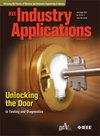尺寸关键型超级电容器存储的放电比优化
IF 4.5
2区 工程技术
Q2 ENGINEERING, ELECTRICAL & ELECTRONIC
引用次数: 0
摘要
超级电容器(SCs)具有适合在短时间内(通常长达几分钟)满足电力需求的特性。SC堆叠的大小受放电比的影响,放电比定义为最小堆叠电压和标称堆叠电压之比。然而,现有的堆栈设计算法没有明确的指导方针来优化该设计参数以获得最小的堆栈大小。通常将放电比设置为任意值,如50$\%$,但已经发现存在最佳放电比选择。本文提出了一种尺寸-最优放电比(SODR),以使SC堆的尺寸最小化。基于负载需求、功率密度和能量密度以及堆的放电效率等因素,解析推导出可集成到现有堆设计算法中的SODR。在SODR的基础上,提出了SC-only和SC/电池混合存储的迭代分级算法。所提出的尺寸策略在1 kW实验室原型的模拟和实验中得到了验证,与现有方法相比,SC堆叠尺寸减少了40美元。本文章由计算机程序翻译,如有差异,请以英文原文为准。
Discharge Ratio Optimization of Supercapacitor Storage for Size-Critical Applications
Supercapacitors (SCs) possess properties suitable for meeting power demands over a short duration, typically up to a few minutes. The size of an SC stack is influenced by the discharge ratio, defined as the ratio of minimum and nominal stack voltages. However, existing stack design algorithms present no clear guidelines for optimizing this design parameter to obtain minimal stack size. The discharge ratio is commonly set to an arbitrary value such as 50$\%$ $\%$
求助全文
通过发布文献求助,成功后即可免费获取论文全文。
去求助
来源期刊

IEEE Transactions on Industry Applications
工程技术-工程:电子与电气
CiteScore
9.90
自引率
9.10%
发文量
747
审稿时长
3.3 months
期刊介绍:
The scope of the IEEE Transactions on Industry Applications includes all scope items of the IEEE Industry Applications Society, that is, the advancement of the theory and practice of electrical and electronic engineering in the development, design, manufacture, and application of electrical systems, apparatus, devices, and controls to the processes and equipment of industry and commerce; the promotion of safe, reliable, and economic installations; industry leadership in energy conservation and environmental, health, and safety issues; the creation of voluntary engineering standards and recommended practices; and the professional development of its membership.
 求助内容:
求助内容: 应助结果提醒方式:
应助结果提醒方式:


